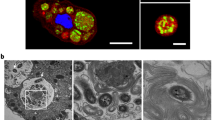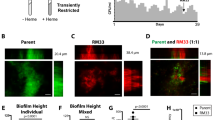Abstract
To survive and proliferate in the absence of oxygen, many enteric pathogens can undergo anaerobic respiration within the host by using nitrate (NO3−) as an electron acceptor1,2. In these bacteria, NO3− is typically reduced by a nitrate reductase to nitrite (NO2−), a toxic intermediate that is further reduced by a nitrite reductase3. However, Vibrio cholerae, the intestinal pathogen that causes cholera, lacks a nitrite reductase, leading to NO2− accumulation during nitrate reduction4. Thus, V. cholerae is thought to be unable to undergo NO3−-dependent anaerobic respiration4. Here, we show that during hypoxic growth, NO3− reduction in V. cholerae divergently affects bacterial fitness in a manner dependent on environmental pH. Remarkably, in alkaline conditions, V. cholerae can reduce NO3− to support population growth. Conversely, in acidic conditions, accumulation of NO2− from NO3− reduction simultaneously limits population expansion and preserves cell viability by lowering fermentative acid production. Interestingly, other bacterial species such as Salmonella typhimurium, enterohaemorrhagic Escherichia coli (EHEC) and Citrobacter rodentium also reproduced this pH-dependent response, suggesting that this mechanism might be conserved within enteric pathogens. Our findings explain how a bacterial pathogen can use a single redox reaction to divergently regulate population expansion depending on the fluctuating environmental pH.
This is a preview of subscription content, access via your institution
Access options
Access Nature and 54 other Nature Portfolio journals
Get Nature+, our best-value online-access subscription
$29.99 / 30 days
cancel any time
Subscribe to this journal
Receive 12 digital issues and online access to articles
$119.00 per year
only $9.92 per issue
Buy this article
- Purchase on Springer Link
- Instant access to full article PDF
Prices may be subject to local taxes which are calculated during checkout




Similar content being viewed by others
Data availability
Raw metabolomic data from V. cholerae samples grown anaerobically in the presence or absence of nitrate and nitrite have been included as Supplementary Information (see Supplementary Dataset).
References
Wallace, N., Zani, A., Abrams, E. & Sun, Y. The impact of oxygen on bacterial enteric pathogens. Adv. Appl. Microbiol. 95, 179–204 (2016).
Vazquez-Torres, A. & Baumler, A. J. Nitrate, nitrite and nitric oxide reductases: from the last universal common ancestor to modern bacterial pathogens. Curr. Opin. Microbiol. 29, 1–8 (2016).
Arkenberg, A., Runkel, S., Richardson, D. J. & Rowley, G. The production and detoxification of a potent cytotoxin, nitric oxide, by pathogenic enteric bacteria. Biochem. Soc. Trans. 39, 1876–1879 (2011).
Braun, M. & Thony-Meyer, L. Cytochrome c maturation and the physiological role of c-type cytochromes in Vibrio cholerae. J. Bacteriol. 187, 5996–6004 (2005).
Lopez, C. A., Rivera-Chavez, F., Byndloss, M. X. & Baumler, A. J. The periplasmic nitrate reductase NapABC supports luminal growth of Salmonella enterica serovar Typhimurium during colitis. Infect. Immun. 83, 3470–3478 (2015).
Spees, A. M. et al. Streptomycin-induced inflammation enhances Escherichia coli gut colonization through nitrate respiration. mBio 4, e00430-13 (2013).
Winter, S. E. et al. Host-derived nitrate boosts growth of E. coli in the inflamed gut. Science 339, 708–711 (2013).
Bueno, E., Mesa, S., Bedmar, E. J., Richardson, D. J. & Delgado, M. J. Bacterial adaptation of respiration from oxic to microoxic and anoxic conditions: redox control. Antioxid. Redox. Signal. 16, 819–852 (2012).
Winter, S. E. et al. Gut inflammation provides a respiratory electron acceptor for Salmonella. Nature 467, 426–429 (2010).
Cole, J. Nitrate reduction to ammonia by enteric bacteria: redundancy, or a strategy for survival during oxygen starvation? FEMS Microbiol. Lett. 136, 1–11 (1996).
Heidelberg, J. F. et al. DNA sequence of both chromosomes of the cholera pathogen Vibrio cholerae. Nature 406, 477–483 (2000).
Almeida, J. S., Julio, S. M., Reis, M. A. & Carrondo, M. J. Nitrite inhibition of denitrification by Pseudomonas fluorescens. Biotechnol. Bioeng. 46, 194–201 (1995).
Fang, F. C. Antimicrobial reactive oxygen and nitrogen species: concepts and controversies. Nat. Rev. Microbiol. 2, 820–832 (2004).
Gao, S. H. et al. Determining multiple responses of Pseudomonas aeruginosa PAO1 to an antimicrobial agent, free nitrous acid. Environ. Sci. Technol. 50, 5305–5312 (2016).
Yarbrough, J. M., Rake, J. B. & Eagon, R. G. Bacterial inhibitory effects of nitrite: inhibition of active transport, but not of group translocation, and of intracellular enzymes. Appl. Environ. Microbiol. 39, 831–834 (1980).
Zhou, Y., Pijuan, M., Zeng, R. J. & Yuan, Z. Free nitrous acid inhibition on nitrous oxide reduction by a denitrifying-enhanced biological phosphorus removal sludge. Environ. Sci. Technol. 42, 8260–8265 (2008).
Lidder, S. & Webb, A. J. Vascular effects of dietary nitrate (as found in green leafy vegetables and beetroot) via the nitrate–nitrite–nitric oxide pathway. Br. J. Clin. Pharmacol. 75, 677–696 (2013).
Tannenbaum, S. R., Fett, D., Young, V. R., Land, P. D. & Bruce, W. R. Nitrite and nitrate are formed by endogenous synthesis in the human intestine. Science 200, 1487–1489 (1978).
Mandlik, A. et al. RNA-Seq-based monitoring of infection-linked changes in Vibrio cholerae gene expression. Cell Host Microbe 10, 165–174 (2011).
Cameron, D. E., Urbach, J. M. & Mekalanos, J. J. A defined transposon mutant library and its use in identifying motility genes in Vibrio cholerae. Proc. Natl Acad. Sci. USA 105, 8736–8741 (2008).
Nygren, E., Li, B. L., Holmgren, J. & Attridge, S. R. Establishment of an adult mouse model for direct evaluation of the efficacy of vaccines against Vibrio cholerae. Infect. Immun. 77, 3475–3484 (2009).
Bergaust, L., Mao, Y., Bakken, L. R. & Frostegard, A. Denitrification response patterns during the transition to anoxic respiration and posttranscriptional effects of suboptimal pH on nitrous oxide reductase in Paracoccus denitrificans. Appl. Environ. Microbiol. 76, 6387–6396 (2010).
Bueno, E., Bedmar, E. J., Richardson, D. J. & Delgado, M. J. Role of Bradyrhizobium japonicum cytochrome c550 in nitrite and nitrate respiration. FEMS Microbiol. Lett. 279, 188–194 (2008).
Rowley, G. et al. Resolving the contributions of the membrane-bound and periplasmic nitrate reductase systems to nitric oxide and nitrous oxide production in Salmonella enterica serovar Typhimurium. Biochem. J. 441, 755–762 (2012).
Kelso, B. H. L., Smith, R. V. & Laughlin, R. J. Effects of carbon substrates on nitrite accumulation in freshwater sediments. Appl. Environ. Microbiol. 65, 5 (1999).
Philips, S., Laanbroek, J. H. & Verstraete, W. Origin, causes and effects of increased nitrite concentrations in aquatic environments. Rev. Environ. Sci. Biotechnol. 1, 26 (2002).
Zakem, E. J. et al. Ecological control of nitrite in the upper ocean. Nat. Commun. 9, 1206 (2018).
Silvester, K. R., Bingham, S. A., Pollock, J. R., Cummings, J. H. & O’Neill, I. K. Effect of meat and resistant starch on fecal excretion of apparent N-nitroso compounds and ammonia from the human large bowel. Nutr. Cancer 29, 13–23 (1997).
Fallingborg, J. Intraluminal pH of the human gastrointestinal tract. Dan. Med. Bull. 46, 183–196 (1999).
Merrell, D. S. et al. Host-induced epidemic spread of the cholera bacterium. Nature 417, 642–645 (2002).
Donnenberg, M. S. & Kaper, J. B. Construction of an eae deletion mutant of enteropathogenic Escherichia coli by using a positive-selection suicide vector. Infect. Immun. 59, 4310–4317 (1991).
Hawver, L. A., Giulietti, J. M., Baleja, J. D. & Ng, W. L. Quorum sensing coordinates cooperative expression of pyruvate metabolism genes to maintain a sustainable environment for population stability. mBio 7, e01863-16 (2016).
A, J. et al. Extraction and GC/MS analysis of the human blood plasma metabolome. Anal. Chem. 77, 8086–8094 (2005).
Gullberg, J., Jonsson, P., Nordstrom, A., Sjostrom, M. & Moritz, T. Design of experiments: an efficient strategy to identify factors influencing extraction and derivatization of Arabidopsis thaliana samples in metabolomic studies with gas chromatography/mass spectrometry. Anal. Biochem. 331, 283–295 (2004).
Jonsson, P. et al. High-throughput data analysis for detecting and identifying differences between samples in GC/MS-based metabolomic analyses. Anal. Chem. 77, 5635–5642 (2005).
Schauer, N. et al. GC–MS libraries for the rapid identification of metabolites in complex biological samples. FEBS Lett. 579, 1332–11337 (2005).
Nicholas, D. J. D. & Nason, A. Determination ofnitrate and nitrite. Meth. Enzymol. 3, 981–984 (1957).
Espaillat, A. et al. Structural basis for the broad specificity of a new family of amino-acid racemases. Acta Crystallogr. D Biol. Crystallogr. 70, 79–90 (2014).
McDonald, N. D., Lubin, J. B., Chowdhury, N. & Boyd, E. F. Host-derived sialic acids are an important nutrient source required for optimal bacterial fitness in vivo. mBio 7, e02237-15 (2016).
Sasabe, J. et al. Interplay between microbial d-amino acids and host d-amino acid oxidase modifies murine mucosal defence and gut microbiota. Nat. Microbiol. 1, 16125 (2016).
Acknowledgements
This work was supported by the Knut and Alice Wallenberg Foundation (KAW), The Laboratory of Molecular Infection Medicine Sweden (MIMS), the Swedish Research Council and the Kempe Foundation. The Waldor Lab is supported by the Howard Hughes Medical Institute (HHMI) and the National Institutes of Health (NIH R01-AI-O42347). B.S. was supported by the National Sciences and Engineering Research Council of Canada (NSERC PSGD3-487259). We thank C. Patthey for help with the cell sorting experiments and J. J. Mekalanos for the V. cholerae C6706 Tn-mutant library.
Author information
Authors and Affiliations
Contributions
E.B. performed the bacterial in vitro experiments and analysed the results. B.S. performed the animal experiments. E.B. and F.C. were responsible for the overall design of the study. E.B., B.S., M.K.W. and F.C. were responsible for the writing of the manuscript.
Corresponding author
Ethics declarations
Competing interests
The authors declare no competing interests.
Additional information
Publisher’s note: Springer Nature remains neutral with regard to jurisdictional claims in published maps and institutional affiliations.
Supplementary information
Supplementary Information
Supplementary Figures 1–15, Supplementary Tables 1–4 and Supplementary References.
Supplementary Dataset
Vibrio cholerae metabolomics under anaerobic conditions supplemented with nitrate or nitrite.
Rights and permissions
About this article
Cite this article
Bueno, E., Sit, B., Waldor, M.K. et al. Anaerobic nitrate reduction divergently governs population expansion of the enteropathogen Vibrio cholerae. Nat Microbiol 3, 1346–1353 (2018). https://doi.org/10.1038/s41564-018-0253-0
Received:
Accepted:
Published:
Issue Date:
DOI: https://doi.org/10.1038/s41564-018-0253-0
This article is cited by
-
Nitrous oxide respiration in acidophilic methanotrophs
Nature Communications (2024)
-
Genomes of Vibrio metoecus co-isolated with Vibrio cholerae extend our understanding of differences between these closely related species
Gut Pathogens (2022)
-
The MarR family regulator OsbR controls oxidative stress response, anaerobic nitrate respiration, and biofilm formation in Chromobacterium violaceum
BMC Microbiology (2021)



